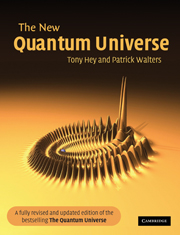Book contents
- Frontmatter
- Contents
- Preface
- Prologue
- Route map
- 1 Waves versus particles
- 2 Heisenberg and uncertainty
- 3 Schrödinger and matter waves
- 4 Atoms and nuclei
- 5 Quantum tunnelling
- 6 Pauli and the elements
- 7 Quantum co-operation and superfluids
- 8 Quantum jumps
- 9 Quantum engineering
- 10 Death of a star
- 11 Feynman rules
- 12 Weak photons and strong glue
- 13 Afterword – quantum physics and science fiction
- Epilogue
- Appendix 1 The size of things
- Appendix 2 Solving the Schrödinger equation
- Glossary
- Quotations and sources
- Suggestions for further reading
- Photo-credits
- Name index
- Subject index
8 - Quantum jumps
Published online by Cambridge University Press: 05 October 2013
- Frontmatter
- Contents
- Preface
- Prologue
- Route map
- 1 Waves versus particles
- 2 Heisenberg and uncertainty
- 3 Schrödinger and matter waves
- 4 Atoms and nuclei
- 5 Quantum tunnelling
- 6 Pauli and the elements
- 7 Quantum co-operation and superfluids
- 8 Quantum jumps
- 9 Quantum engineering
- 10 Death of a star
- 11 Feynman rules
- 12 Weak photons and strong glue
- 13 Afterword – quantum physics and science fiction
- Epilogue
- Appendix 1 The size of things
- Appendix 2 Solving the Schrödinger equation
- Glossary
- Quotations and sources
- Suggestions for further reading
- Photo-credits
- Name index
- Subject index
Summary
We always have had a great deal of difficulty in understanding the world view that quantum mechanics represents. At least I do, because I'm an old enough man that I haven't got to the point that this stuff is obvious to me … It has not yet become obvious to me that there is no real problem. I cannot define the real problem, therefore I suspect there is no real problem, but I'm not sure there's no real problem.
Richard FeynmanMax Born and quantum probabilities
In this chapter, we will take a short break from our survey of successful applications of quantum mechanics to take a closer look at the foundations of this great edifice of modern physics. In a sense, we are now disobeying Feynman's warning about the results of the double slit experiment of chapter 1. We shall now ask Feynman's ‘forbidden’ question ‘But how can it be like that?’ Nobody disputes that quantum mechanics has been magnificently successful, enabling us to make correct quantitative calculations of atomic and nuclear effects. But there is a great divergence of opinion about the implications of quantum mechanics for the nature of matter, and indeed, of reality itself. To avoid becoming embroiled in a purely philosophical mire, we will focus on two famous paradoxes. The first of these is the ‘Einstein–Podolsky-Rosen’ paradox, named after its originators Albert Einstein, Boris Podolsky and Nathan Rosen, and usually abbreviated by the initials ‘EPR’. The second paradox is named after ‘Schrödinger's cat’.
- Type
- Chapter
- Information
- The New Quantum Universe , pp. 157 - 180Publisher: Cambridge University PressPrint publication year: 2003



